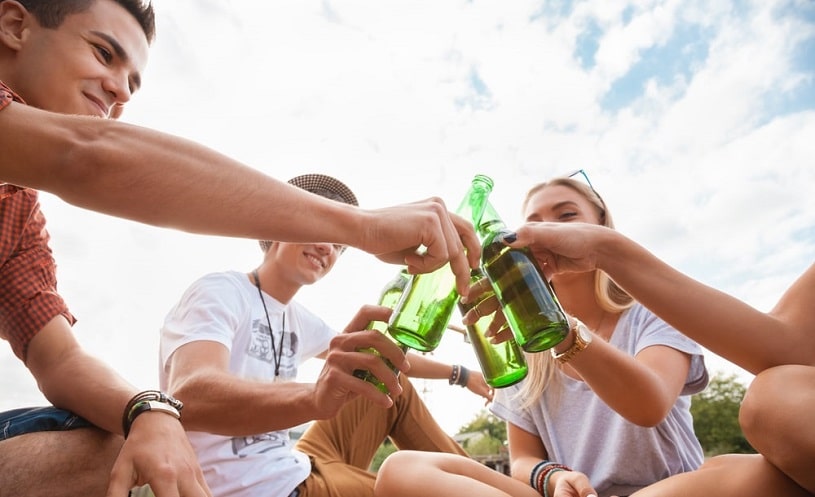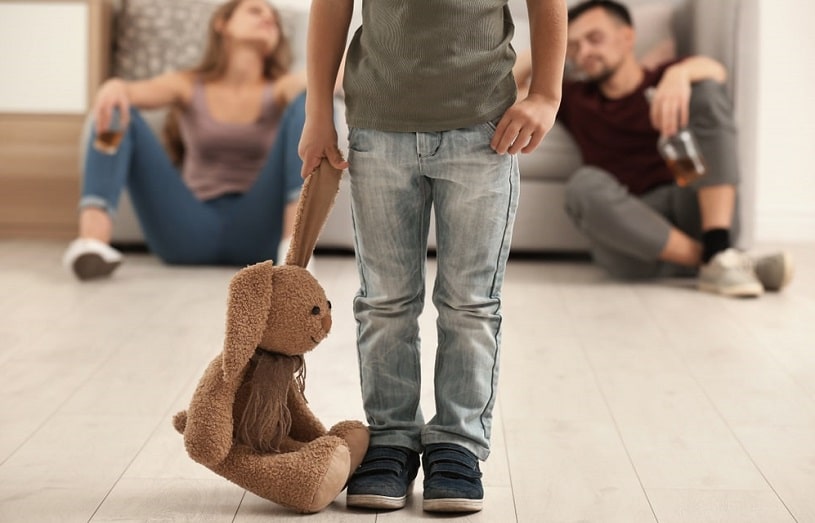Underage drinking refers to anyone under the minimum legal age consuming any type or quantity of alcohol. It can be very tempting for teens and young adults to experiment with alcohol, but the risks of doing so can be severe. Many young people have no idea just how harmful drinking can be to physical health, mental health, brain development, and an individual’s actions and choices. Several factors contribute to teenage drinking and can have severe short-term and long-term consequences not just for the teenager but also for their friends and family.
Table Of Contents:
- How Old Should One Be in the U.S. to Drink Legally?
- What are the Causes of Underage Drinking?
- What are the Effects of Underage Drinking?
- What are Some Underage Drinking Stats?
- What are the Common Drinking Patterns in Teens?
- What are the Different Types of Teenage Drinkers?
- What are the Dangers of Drinking Under 21?
- What are the Warning Signs of Underage Drinking?
- How to Prevent Alcohol Use in Teens?
- What to Do with a Teenager with an Alcohol Problem?

Read along further to find out about teen drinking, teenage and alcohol problems, the causes and factors which contribute towards teens and alcohol consumption, some teenage drinking stats, and information about seeking help in case of a problem with alcohol abuse.
How Old Does One Have to Be to Drink Alcohol in the U.S.?
An individual must be at least 21 years old to drink alcohol in every state in the U.S. This age limit was put in place to protect young people’s health and reduce the number of accidents on the road caused by drinking.
The legal age has long been a subject for debate. Before the mid-1980s, it was set at 18, but it was soon after raised to 21 primarily to reduce the number of highway fatalities that occurred due to teenage drinking.

However, the set age limit has not stopped all minors from drinking, and some experts even believe it has contributed to excessive consumption of liquor. Critics of the 21 age limit are pushing for it to be dropped again to 18.
A central argument made by the proponents of a younger legal age is that restricting alcohol to 21 and older has only forced teen drinking underground, into settings that adults cannot manage.
Whether the age limit is set at 18 or 21, science points out that the effects of alcohol on adolescents’ still-developing brains are significant.
Causes of Adolescent Drinking
As children grow up and move from adolescence to adulthood, they experience various physical, psychological, and emotional changes. These changes may provoke them to start consuming alcohol to cope up. There could be other factors as well that are responsible for teenagers to start drinking.
Some of The Causes of Underage Drinking are Described Below:
Peer Pressure
Peer pressure is considered the most common reason for a teenager drinking. When kids are growing up, their friends start influencing their life choices and decisions. In an effort to fit in and be accepted among their friends, kids and teenagers may start drinking if their friends drink as well.
Environmental Factors
Environmental influences also play a role in teenagers starting the drink. Social media, advertisements, movies, and T.V. all make drinking look cool and desirable. This has a negative influence on teenagers who feel like they are missing something by not drinking.
Genetics
Research shows that genetics and hereditary factors also increase or decrease a person’s risk for alcohol-related problems and drug abuse. Children of alcoholics are 4 to 10 times more likely to become alcoholics themselves than children with no close relatives having an alcoholic problem.
To Cope-Up With An Underlying Problem
Because of puberty and other psychological and emotional pressures, teens often find themselves in situations where they feel stressed, depressed, or bored. This can become a reason for them to start drinking. Specific mental health issues can also cause teenagers to self-medicate and start using alcohol as a coping mechanism.
Lack Of Parental Monitoring And Guidance
Teenagers and children need boundaries, rules, direction, and structure in their lives to guide them through the tough years of adolescence. In the absence of such discipline and structure, they can fall prey to drinking and not worry about the consequences.

Childhood Trauma
Childhood trauma such as physical abuse, sexual abuse, violent victimization, witnessing violence, and other traumatic events can become a risk factor for developing a drinking habit when they grow older.
Family Dynamics
Parents who abuse alcohol or express favorable attitudes towards drinking can influence their children and become the reason for them to start drinking before adulthood.
Effects of Drinking On the Developing Body and Brain
When teenagers start to drink, they are at risk of developing various diseases and adverse health effects. Teens and alcohol consumption can have devastating effects on their brain and body development.
These Are Discussed Below:
Effects On The Brain
Alcohol can cause damage to the developing brain in many ways. Alcohol slows down the functioning of the brain and can lead to cognitive functional impairment.
It can also affect a person’s judgment, balance, and mood.
Alcohol affects the brain of anybody who consumes it in one way or another, regardless of age. The problem with underage drinking, however, is that the brain is still developing. This means that teens consuming liquor may be more vulnerable to its harmful effects.
Effects On The Liver
Young children and teenagers who drink are at an increased risk of having elevated liver enzymes, indicating some degree of liver damage. In children who are overweight or obese, liver damage can be caused even with moderate liquor consumption.
Effects On Growth And Development
Consuming alcohol during the adolescent years can upset the body’s hormonal balance, necessary for the normal development of organs, muscles, and bones. It also negatively affects the reproductive system’s maturation by interfering with estrogen and testosterone amounts produced.
Statistics About Teenagers With Alcohol Issues
The number of young people who drink and how much they drink is staggering and presents a significant public health issue.
Some of the Recent Teenage Drinking Stats in the U.S. Include the Following:
- One-third of drunk-driving deaths involve people between the ages of 16 and 20.
- There are about 10.8 million underage drinkers in the U.S.
- One in every 16 teenagers binge drinks.
- Only one in 100 parents believe that their teenage child binge drinks.
- According to the Arizona Youth Survey in 2008, 24 percent of 8th graders, 39 percent of 10th graders, and 47 percent of 12th graders in the state claimed that they drank alcohol at least once in the last 30 days.
- Forty percent of those who start drinking before the age of 15 will develop an alcohol use disorder at some point in their lifetime.
- One percent of 15-year-olds have reported having had at least one drink in their lives.
- In 2017, 26.4% of all fatal crashes in North Carolina involved an underage driver who was driving while drunk.
- In 2019, about 24.6% of children aged 14 to 15 years old reported having at least one drink in their lives.
- In 2019, 7 million youngsters aged 12 to 20 years admitted to drinking beyond a few sips in the past 30 days.
Drinking Patterns in Teenagers
Teens and alcohol drinking patterns vary with age and gender. Usually, it begins during adolescence and worsens as the children grow older. According to the National Institute on Alcohol Abuse and Alcoholism statistics, the percentage of adolescents aged 12 to 13 who drink is lesser than the rate of adolescents aged 16 to 17 who consume alcohol.

Also, historically there was a trend that teenage boys were likely to drink and binge drink as compared to adolescent girls. The same statistics show that the trend has reversed, and more teenage girls are currently consuming liquor and binge drinking than teenage boys.
Types Of Teenage Drinkers
According to the Substance Abuse and Mental Health Service Administration SAMHSA, Teenager Drinkers Can Be Divided Into the Following Four Categories:
- Non-Drinkers: These include teenagers who did not drink any kind of liquor in the past 30 days.
- Light Drinkers: These are the ones who consumed at least 1 but less than 5 drinks on a single occasion in the past 30 days.
- Binge Drinkers: These include those teenagers that consume 5 or more alcoholic drinks on at least one occasion but no more than four occasions during the past 30 days.
- Heavy Drinkers: This category includes teenagers who consumed 5 or more drinks on one occasion for 5 or more days in the last month.
Dangers of Drinking By Teenagers
The percentage of underage drinking in the U.S. can be surprising to adults, and the consequences are severe. Young people are more vulnerable to the risks of being intoxicated because they have little to no alcohol tolerance. They are more likely to be subjected to peer pressure and have brains that are still developing.
Dangers to the Individual Drinker Include:
- An increased risk of developing an alcohol use disorder.
- An increased risk of damage to the brain or liver.
- An increased risk of trying other drugs, including everything from cigarettes to cocaine, due to lowered inhibitions caused by alcohol. Mixing drugs like this presents its own physiological, psychological, and social problems.
- An increased risk of sexual abuse, risky sexual behavior, and unwanted sexual experiences due to lowered inhibitions.
- Impaired driving ability, with the possibility of fatal crashes.
Effects on Lifestyle
Alcohol can have a significant impact on physical wellness and safety, but it also affects other aspects of a person’s life. Most underage drinkers are in school or college. Drinking and hangovers cut into study time and have a negative impact on academic outcomes. Poor academic performance can have lasting consequences.
Drinking can also impact work, reducing performance, and contributing to lateness or missed days. It may also affect relationships with family, friends, and romantic partners.
Violence, Aggression, and Legal Issues
Alcohol changes mood, and in some people consuming liquor increases levels of violence and aggression. Teens and alcohol consumption can lead to fights, assaults, and even crimes that put a young person in a precarious legal situation. Underage drinking consequences may include a criminal record, which impacts every area of a person’s future.
Risky Sexual Behavior
Teens and alcohol consumption is linked with risky sexual behavior. Adolescents who drink are more likely to have sex before the age of 16, and they are less likely to practice safe sex when drunk.
Risky Behavior
Teen drinking has been associated with increased risky behavior and victimization. This results in crime, violence, homicide, suicides, accidents, and injuries.
Delayed Puberty And Bone Growth
During the adolescent years, teenage and alcohol consumption has been shown to delay puberty, slow bone growth, lower bone density, and result in weaker bones.
Emotional And Behavioral Problems
Underage drinking causes a wide range of emotional and behavioral problems such as depression, aggression, skipping school, stealing, fighting, risky behavior, driving while drunk, and others.
Long-Term Consequences
Research suggests that children who start drinking before the age of 15 are more likely to develop alcohol dependence than those who drink after 15. It causes low self-esteem, depression, conduct disorders, antisocial behavior, alcohol, and other drug abuse.
Some Warning Signs of Drinking by Underage People
There are many risks of underage drinking, but parents, friends, and other people in a young person’s life can make a difference, especially if they can recognize the warning signs.
Although some teenage and alcohol problem signs may be fairly obvious, especially catching someone drunk, some problem drinking signs are less visible.
Changes in Behavior or Academic Performance
Alcohol can cause mood swings, irritability, aggressiveness, tiredness, and other changes, often expressed as unusual behavior. If these symptoms develop independently from other factors, it can be a sign of alcohol or drug use.

Worsening grades, skipping classes, or disruptive behavior in a previously good student can also be important warning signs to teachers and parents that something isn’t right. Consuming liquor is a common cause of such issues.
Losing Interest in Usual Activities
A sudden change in hobbies, giving up activities that a teenager used to enjoy, to do seemingly nothing, can be a warning sign. The activities may have been replaced by alcohol and drinking with friends.
Concentration and Memory Problems
Heavy drinking can lead to memory loss and difficulty concentrating, especially after drinking while experiencing a hangover. If a young person cannot remember where they were, what they were doing, or who they were doing something with, this is a potential warning sign of drinking.
Changing Friends
To some extent, this is a natural part of growing up, and many young people will hang out with different friends throughout their time at school. However, rapidly changing friends, mostly if there were no problems in previous friendships, can be a warning sign. Also, a warning sign is being secretive about friends and activities.
Preventing Adolescent Drinking
Experimenting with alcohol is common among young people. While parents and other adults may not be able to eliminate this behavior, they can discourage adolescent drinking and encourage smart decisions.
Build Trust and Communication
For parents and children, an open and honest relationship is essential. This allows for a positive dialogue in which parents can discuss the dangers of alcohol and peer pressure, along with keeping an eye out for any warning signs.
Kids should always be given a chance to ask questions, get honest answers, and discuss how they feel about alcohol and other difficult subjects. This builds trust and communication, essential foundations for a healthy relationship.
Encourage Positive Activities
To discourage underage drinking, teenagers should be allowed to explore hobbies and activities. These may be completely different from their parents’ interests, but they should be encouraged as long as they are positive. However, teenagers shouldn’t be forced to do activities they do not find interesting or enjoyable. That can act as a stressor that will lead to distrust between parent and child, creating another reason to drink.
While teens drinking alcohol is never acceptable and should be discouraged because of the potential and severe dangers, young people should also feel able to contact their parents or other trusted adults when in risky situations. Positive and trusting relationships with their parents help teens make better choices and keep them safe when making the wrong choices.
Become A Positive Adult Role Model
The parents should become positive role models for the children so that the children can learn to be like them. This means that parents should stay away from alcohol in high-risk situations, keep alcohol away from children, limit their alcohol intake, and seek help if they have an alcohol-related problem.
Be Aware Of The Factors That May Increase The Risk Of A Child’s Alcohol Use
Parents should be aware of the factors that can increase the risk of their child’s alcohol use. These are significant social transitions, social or emotional problems, depression, and other mental health disorders. A family history of alcoholism and peers involved in consuming booze can also act as factors that push a teenager to drink.
Seeking Treatment If You Are A Teenager With An Alcohol Problem
Acknowledging a problem doesn’t make anyone weak or lesser of a person. It takes tremendous courage and strength to admit one’s mistakes and problems and discuss them with someone else to make things right. If you are a child or teenager who is concerned with your own or a friend’s alcohol problem, it is important to reach out to an adult either in the family or someone you trust. This can be an adult family friend, an older sibling, a school counselor, a teacher, or anyone you trust. Іeveral national helplines and resources can help in every possible way in the case of teenage drinking problems.
Hope Without Commitment
Find the best treatment options. Call our free and confidential helpline
Most private insurances accepted
Page Sources
- Johnson, S. B., Blum, R. W., & Giedd, J. N. (2009). Adolescent maturity and the brain: the promise and pitfalls of neuroscience research in adolescent health policy. Journal of Adolescent Health, 45(3), 216-221., http://www.ncbi.nlm.nih.gov/pmc/articles/PMC2892678/
- National Institute on Alcohol Abuse and Alcoholism, Underage Drinking, https://www.niaaa.nih.gov/publications/brochures-and-fact-sheets/underage-drinking
- U.S. National Library of Medicine, MedlinePlus. Risks Of Underage Drinking, https://medlineplus.gov/ency/patientinstructions/000528.htm
- Substance Abuse and Mental Health Services Administration (SAMHSA). What You Can Do To Prevent Your Child From Drinking, https://www.samhsa.gov/underage-drinking/parent-resources/what-you-can-do-prevent-your-child-drinking
- Harding, F. M., Hingson, R. W., Klitzner, M., Mosher, J. F., Brown, J., Vincent, R. M., ... & Cannon, C. L. (2016). Underage drinking: a review of trends and prevention strategies. American journal of preventive medicine, 51(4), S148-S157., https://www.sciencedirect.com/science/article/pii/S0749379716301921
- Department of Mental Health and Addiction Services, Underage Drinking, https://portal.ct.gov/DMHAS/Prevention%20Unit/Prevention%20Files/Underage%20Drinking
- U.S. Department of Health and Human Services. (2006). Underage drinking: why do adolescents drink, what are the risks, and how can underage drinking be prevented. Alcohol Alert, 67, 1-7, .https://pubs.niaaa.nih.gov/publications/AA67/AA67.htm
- Arizona Youth Survey. (2008). Shining Light on Arizona Youth, Arizona Criminal Justice Commission, https://acjctest.azcjc.gov/sites/default/files/pubs/City_of_Phoenix_AYS_Profile_Report.pdf
- The Surgeon General's Call to Action, To Prevent and Reduce Underage Drinking, https://www.hhs.gov/sites/default/files/underage-drinking-community-guide.pdf
- Underage Drinking: North Carolina Department Of Public Safety, https://www.ncdps.gov/our-organization/law-enforcement/alcohol-law-enforcement/underage-drinking
- Substance Abuse and Mental Health Services Administration (SAMHSA). 2019 National Survey on Drug Use and Health. Table 2.6B— Alcohol Use in Lifetime, Past Year, and Past Month among Persons Aged 12 or Older, by Detailed Age Category: Percentages, 2002-2019, https://www.samhsa.gov/data/sites/default/files/reports/rpt29394/NSDUHDetailedTabs2019/NSDUHDetTabsSect2pe2019.htm#tab2-6b.
- Substance Abuse and Mental Health Services Administration (SAMHSA). 2019 National Survey on Drug Use and Health. Table 7.16A— Alcohol Use in Lifetime, Past Year, and Past Month among Persons Aged 12 to 20, by Gender: Numbers in Thousands, 2002-2019., https://www.samhsa.gov/data/sites/default/files/reports/rpt29394/NSDUHDetailedTabs2019/NSDUHDetTabsSect7pe2019.htm#tab7-16a.
- Chen, C. M., Yoon, Y. H., & Faden, V. B. (2017). Surveillance Report# 101: Trends in Underage Drinking in the United States, 1991–2015., https://pubs.niaaa.nih.gov/publications/surveillance107/Underage15.htm
- Dees, W. L., Hiney, J. K., & Srivastava, V. K. (2017). Alcohol and Puberty: Mechanisms of Delayed Development. Alcohol research: current reviews, 38(2), 277., https://arcr.niaaa.nih.gov/alcohol-organ-interactions-injury-and-repair/alcohol-and-puberty-mechanisms-delayed-development
- National Research Council and Institute of Medicine. 2004. Reducing Underage Drinking: A Collective Responsibility. Washington, DC: The National Academies Press. https://doi.org/10.17226/10729.

 Authored by
Authored by  Reviewed by
Reviewed by 